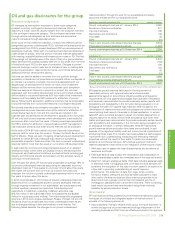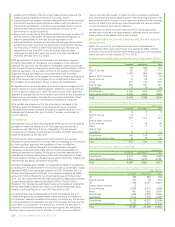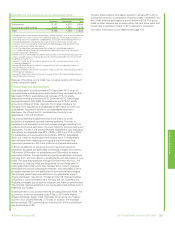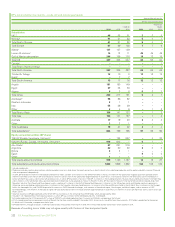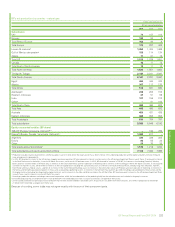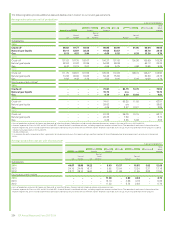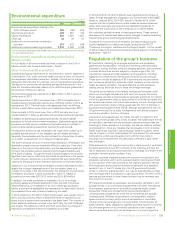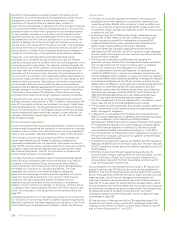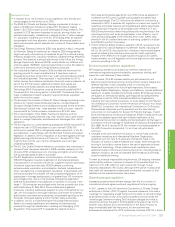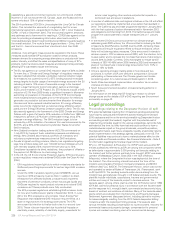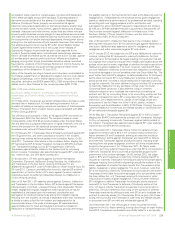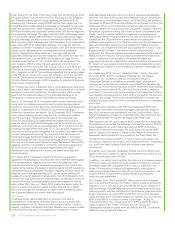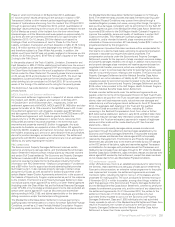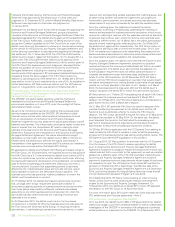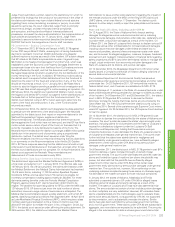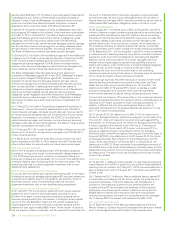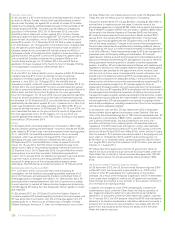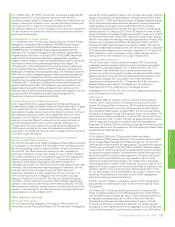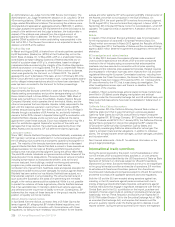BP 2014 Annual Report Download - page 233
Download and view the complete annual report
Please find page 233 of the 2014 BP annual report below. You can navigate through the pages in the report by either clicking on the pages listed below, or by using the keyword search tool below to find specific information within the annual report.
remediation costs, claims for unpaid wages, injunctive and declaratory
relief, treble damages and punitive damages. Purported classes of
claimants include residents of the states of Louisiana, Mississippi,
Alabama, Florida and Texas; property owners and rental agents,
fishermen and persons dependent on the fishing industry, charter boat
owners and deck hands, marina owners, gasoline distributors, shipping
interests, restaurant and hotel owners, cruise lines and others who are
property and/or business owners alleged to have suffered economic loss;
and response workers and residents claiming injuries due to exposure to
the components of oil and/or chemical dispersants. Among other claims
arising from the spill response efforts, lawsuits have been filed claiming
that additional payments are due by BP under certain Master Vessel
Charter Agreements entered into in the course of the Vessels of
Opportunity Program implemented as part of the response to the
Incident. Purported class action and individual lawsuits have also been
filed in US state and federal courts, as well as one suit in Canada, against
BP entities and/or various current and former officers and directors
alleging, among other things, shareholder derivative claims, securities
fraud claims, violations of the Employee Retirement Income Security Act
(ERISA) and contractual and quasi-contractual claims related to the
cancellation of the dividend on 16 June 2010.
Many of the lawsuits pending in federal court have been consolidated by
the Federal Judicial Panel on Multidistrict Litigation into two multi-district
litigation proceedings, one in federal district court in Houston for the
securities, derivative and ERISA cases (MDL 2185) and another in federal
district court in New Orleans for the remaining cases (MDL 2179).
MDL 2179 and related matters
DoJ Action; liability limitation-, contribution- and indemnity-related
proceedings; and Trial of Liability, Limitation, Exoneration and Fault
Allocation
On 13 May 2010, Transocean and certain affiliates filed a complaint under
admiralty law in federal court in Texas seeking exoneration from or
limitation of liability as managing owners and operators of the Deepwater
Horizon. That action (the Limitation Action) was consolidated with MDL
2179 on 24 August 2010.
The US filed a civil complaint in MDL 2179 against BPXP and others on
15 December 2010 (the DoJ Action). The complaint seeks an order
finding liability under OPA 90 and civil penalties under the Clean Water
Act and sets forth a purported reservation of rights on behalf of the US to
amend the complaint or file additional complaints seeking various
remedies under various US federal laws and statutes.
On 18 February 2011, Transocean filed a third-party complaint against BP,
the US government, and other corporations involved in the Incident,
naming those entities as formal parties in the Limitation Action. On 20
April 2011, Transocean filed claims in the Limitation Action alleging that
BP had breached BP America Production Company’s (BPAPC) contract
with Transocean Holdings LLC by BP not agreeing to indemnify
Transocean against liability related to the Incident and by not paying
certain invoices. Transocean also asserted claims against BP under state
law, maritime law, and OPA 90 for contribution.
On 20 April 2011, BP filed claims against Cameron International
Corporation (Cameron), Halliburton Energy Services, Inc. (Halliburton),
and Transocean in the DoJ Action, seeking contribution for any
assessments against BP under OPA 90 based on those entities’ fault. On
20 June 2011, Cameron and Halliburton moved to dismiss BP’s claims
against them in the DoJ Action. BP’s claim against Cameron has been
resolved pursuant to settlement (described below), but Halliburton’s
motion remains pending.
Also on 20 April 2011, BP asserted claims against Cameron, Halliburton
and Transocean in the Limitation Action. BP’s claims against Transocean
include breach of contract, unseaworthiness of the Deepwater Horizon
vessel, negligence (or gross negligence and/or gross fault as may be
established at trial based upon the evidence), contribution and
subrogation for costs (including those arising from litigation claims)
resulting from the Incident, as well as a declaratory claim that Transocean
is wholly or partly at fault for the Incident and responsible for its
proportionate share of the costs and damages. BP asserted claims
against Halliburton for fraud and fraudulent concealment based on
Halliburton’s misrepresentations to BP concerning, among other things,
the stability testing on the foamed cement used at the Macondo well; for
negligence (or, if established by the evidence at trial, gross negligence)
based on Halliburton’s performance of its professional services, including
cementing and mud logging services; and for contribution and
subrogation for amounts that BP has paid in responding to the Incident,
as well as in OPA 90 assessments and in payments to the plaintiffs. BP
filed a similar complaint against Halliburton in federal court in the
Southern District of Texas, Houston Division, and the action was
transferred to MDL 2179 on 4 May 2011.
Also on 20 April 2011, Halliburton filed claims in the Limitation Action
seeking indemnification from BP for claims brought against Halliburton in
that action. Halliburton also asserted a claim for negligence, gross
negligence and wilful misconduct against BP and others.
On 31 January 2012, the judge ruled on BP’s and Halliburton’s indemnity
motions, holding that BP is required to indemnify Halliburton for third-
party claims for compensatory damages resulting from pollution that did
not originate from property or equipment of Halliburton located above the
surface of the land or water, regardless of whether the claims result from
Halliburton’s gross negligence. The court, however, ruled that BP does
not owe Halliburton indemnity to the extent that Halliburton is held liable
for punitive damages or for civil penalties under the Clean Water Act. The
court further held that BP’s obligation to defend Halliburton for third-party
claims does not require BP to fund Halliburton’s defence of third-party
claims at this time, nor does it include Halliburton’s expenses in proving
its right to indemnity. The court deferred ruling on whether BP is required
to indemnify Halliburton for any penalties or fines under the Outer
Continental Shelf Lands Act. It also deferred ruling on whether
Halliburton acted so as to invalidate the indemnity by breaching its
contract with BP, by committing fraud, or by committing another act that
materially increased the risk to BP or prejudiced the rights of BP as an
indemnitor. On 4 September 2014, as part of its findings of fact and
conclusions of law for Phase one of the Trial of Liability Limitation
Exoneration and Fault Allocation in MDL 2179 (Phase 1 Ruling), the court
ruled that Halliburton’s indemnity and release clauses in its contract with
BP are valid and enforceable against BP.
On 30 May 2011, Transocean filed claims against BP in the DoJ Action
alleging that BPAPC had breached its contract with Transocean Holdings
LLC by not agreeing to indemnify Transocean against liability related to
the Incident. Transocean also asserted claims against BP under state law,
maritime law and OPA 90 for contribution.
On 1 November 2011, Transocean filed a motion for partial summary
judgment on certain claims filed in the Limitation Action and the DoJ
Action between BP and Transocean, seeking an order that would bar
BP’s contribution claims against Transocean and require BP to defend
and indemnify Transocean against all pollution claims, including those
resulting from any gross negligence, and from civil fines and penalties
sought by the government. On 7 December 2011, BP filed a cross-
motion for summary judgment seeking an order that BP is not required to
indemnify Transocean for any civil fines and penalties sought by the
government or for punitive damages. On 26 January 2012, the judge
ruled on BP’s and Transocean’s indemnity motions, holding that BP is
required to indemnify Transocean for third-party claims for compensatory
damages resulting from pollution originating beneath the surface of the
water, regardless of whether the claim results from Transocean’s strict
liability, negligence or gross negligence. The court, however, ruled that
BP is not required to indemnify Transocean for such claims to the extent
Transocean is held liable for punitive damages or for civil penalties under
the Clean Water Act, or if Transocean acted with intentional or wilful
misconduct in excess of gross negligence. The court further held that
BP’s obligation to defend Transocean for third-party claims does not
require BP to fund Transocean’s defence of third-party claims at this
time, nor does it include Transocean’s expenses in proving its right to
indemnity. The court deferred a final ruling on the question of whether
Transocean breached its drilling contract with BP so as to invalidate the
contract’s indemnity clause. On 4 September 2014, as part of its Phase 1
Ruling, the court ruled that Transocean’s indemnity and release clauses
in its contract with BP are valid and enforceable against BP.
On 8 December 2011, the US brought a motion for partial summary
judgment in the DoJ Action seeking, among other things, an order finding
that BPXP, Transocean and Anadarko are strictly liable for a civil penalty
Additional disclosures
★Defined on page 252. BP Annual Report and Form 20-F 2014 229


